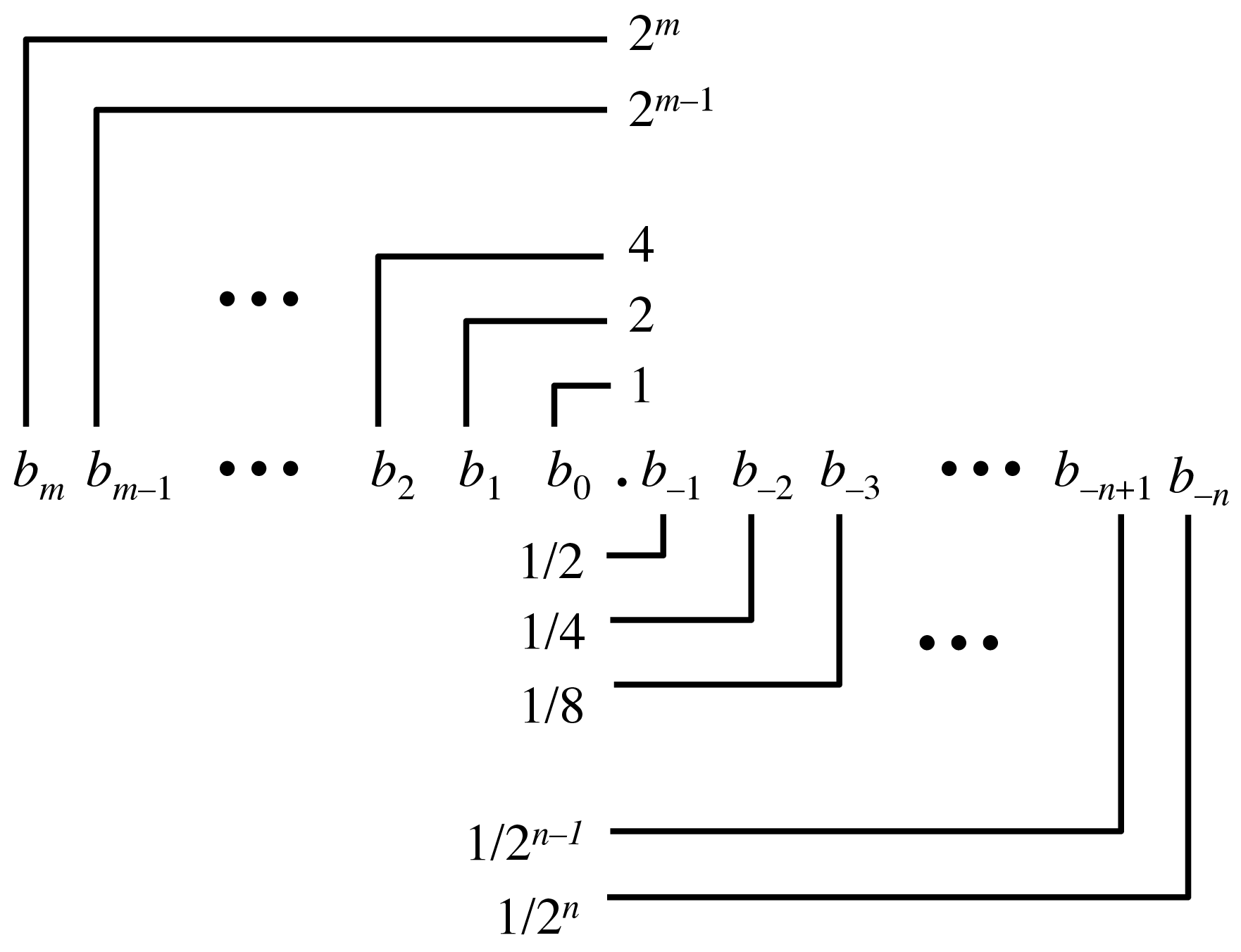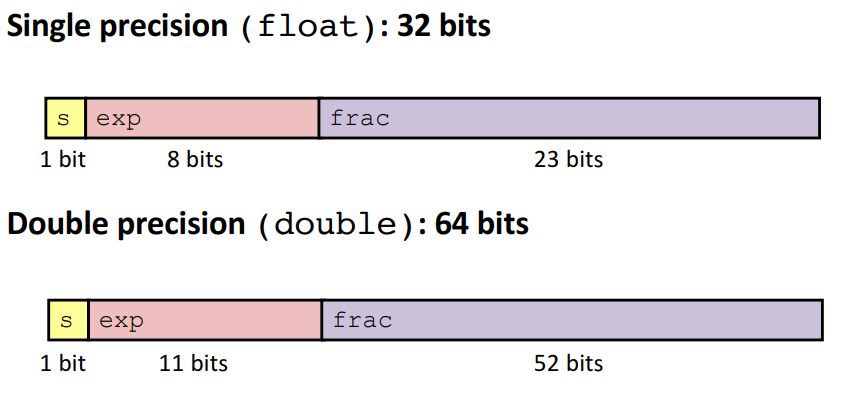CS 208 s20 — IEEE Floating Point
Table of Contents
1 Introduction
- We will not cover all the complexities of the 50-page IEEE floating point standard
- It saved us from the wild west in the early days of computing where every manufacturer was designing their own floating point representation
- These were typically optimized for performance at the cose of accuracy
- What do we want from a floating point standard?
- Scientists/numerical analysts want them to be as real as possible
- Engineers want them to be easy to implement and fast
- Scientists mostly won, as floating-point operations can be several times slower than integer operations
- Basic idea: represent numbers in binary scientific notation
2 Fractional Binary Numbers
The idea of a binary fraction is part of the IEEE representation, so let's start with that.

- Example
0b10.1010= \(1\times2^1 + 1\times2^{-1} + 1\times2^{-3} = 2.625\) - Exercise: what's the closest we can get to 1/3 with 6 bits?1
| fraction | decimal |
|---|---|
| 1/2 | 0.5 |
| 1/4 | 0.25 |
| 1/8 | 0.125 |
| 1/16 | 0.0625 |
| 1/32 | 0.03125 |
| 1/64 | 0.015625 |
- Exercise: What is the base 10 equivalent of the 6-bit two's complement fixed-point number
0b101.110?2
3 IEEE floating point in 6 bits
- The value \(V\) of a floating point number is computed using the following formula: \(V = (-1)^s \times M \times 2^E\)
- sign: \(s\) indicates positive or negative (sign bit when \(V=0\) is special case)
- significand: \(M\) fractional binary number between 1 and \(2 - \epsilon\) or between 0 and \(1 - \epsilon\)
- exponent: \(E\) weights by a power of 2 (can be negative power)
- We will choose to distribute our 6 bits to represent these quantities as follows:
sencodes \(s\)expencodes \(E\) in biased form- normally, \(E\) =
exp\(- Bias\) where the \(k\) bits ofexpare treated as an unsigned integer and \(Bias = 2^{k-1} - 1\)
- normally, \(E\) =
fracis the binary fraction \(0.f_{n-1}\cdots f_1f_0\), and the significand is \(M = 1 + f\)

3.1 Example
- Take the same six bits from before,
0b1 011 10, what value do they represent under this scheme?sis 1, so value is negativeexpis 3, so \(E = 3 - 3 = 0\)fracis 0.5, so \(M = 1 + 0.5 = 1.5\)- V = -1.5 × 20 = -1.5
3.2 Exercise
- With 1 sign bit, 3 exponent bits, and 2 significand bits, how close can we get to 1/33
- using the formula from the example above
3.3 Why the biased form for exponents?
- we want to represent very small and very large numbers, so we need the exponent to be signed
- this suggests encoding
expas a two's complement integer
- this suggests encoding
- we want floating-point operations to be fast in hardware
- easier to compare floats if more 1s in
expmeans bigger number
- easier to compare floats if more 1s in
- clever trick: store
expas unsigned with implicit bias- in fact, by putting
expin betweensandfrac, the same hardware can do two's complement comparisons and floating-point comparisons
- in fact, by putting
3.4 Denormalized values
- When
expis 0, the representation switches from normalized to denormalized form- \(E = 1 - Bias\)
- \(M = f\)
4 Real IEEE
4.1 Reading: IEEE Floating Point Representation
Read section 2.4.2 from the CSPP book (p. 112–115), and take a look at figure 2.34 on p. 115.


4.2 Special cases

5 Useful simulation
6 Arithmetic
- IEEE standard specifies four rounding modes
- typically round-to-even, helps avoid statistical bias in practice by distributing rounding between rounding up and rounding down
- In general, perform exact computation and then round to something representable with available bits
- can underflow if closest representable value is 0
- can overflow if \(E\) is too big to fit in
exp(result is \(\pm\infty\)) - rounding breaks associtivity
7 Homework
- Do practice problem 2.47 in the CSPP book (p. 117)
- Remember that lab 0 is due at 9pm tonight (April 20). You can use late days, see the course web page for the late work policy.
- Lab 1 has been posted. It will be due 9pm Wednesday, April 29. Part of the provided testing framework, the executable
dlc, will only run on a Linux system or VM.
Footnotes:
1
.010101 (1/4 + 1/16 + 1/64 = 0.328125)
2
Two's complement means the most significant bit has negative weight: 0b101.110 = \(-4 + 1 + 0.5 + 0.25 = -2.25\)
3
0 001 01 (sign exponent significand) yields \(1.25 \times 2^{1 - 3} = 1.25 \times 2^{-2} = 0.3125\).
This isn't as close as with a 6-bit binary fraction we could structure however we wanted, but an unstructured representation would require extra bits to locate the binary point.